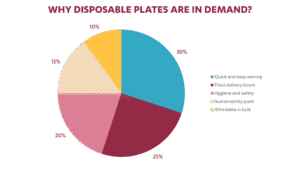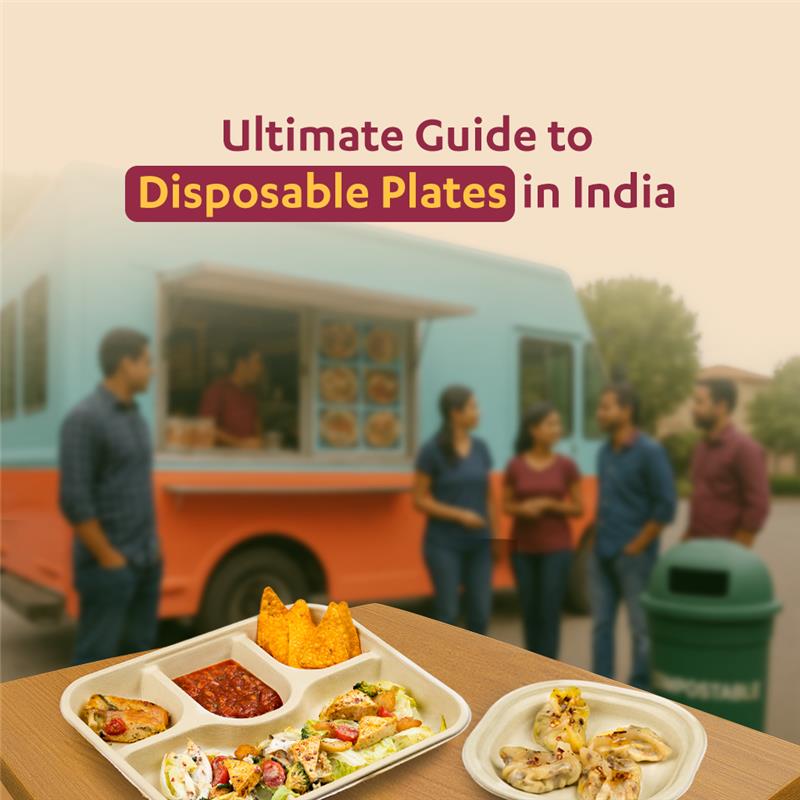Imagine a bustling food street corner in Delhi, a wedding pandal in Jaipur, or a team lunch at a Bengaluru startup — food is being served fast, hot, and generously. What’s holding it all together? Disposable plates.
Disposable plates have quietly become the unsung heroes of modern India’s food culture. They’ve come to offer convenience and meet scalable demands. And demand is only rising. According to a 2023 report by IMARC Group, the Indian disposable tableware market is expected to reach ₹35,000 crore by 2028, driven by growing urbanization, hygiene awareness, and eco-conscious choices.
But with so many options out there — paper plates, plastic plates, sugarcane bagasse plates, leaf plates and more — choosing the best disposable plate for your needs isn’t as simple as it once was. Especially today, when what we eat on matters almost as much as what we eat.
Whether you’re a restaurant owner, a caterer, or just someone hosting Sunday brunch for 20, you’ve probably asked yourself:
Which disposable plate is sturdy enough? Safe enough? Eco-friendly enough?
In this ultimate guide to buying disposables in India, we break it all down — from the different types of disposable plates available, to what really matters before you buy. Backed by insights, checklists, and buying tips — this guide helps you make a smart, sustainable choice.
Let’s start.
Why Disposable Plates Are in High Demand in India
In a country as diverse and fast-moving as India, convenience matters. That’s one of the biggest reasons why disposable plates — also called use and throw plates — are used everywhere, from street food stalls and weddings to office lunches and cloud kitchens.
But that’s not the only reason demand is soaring.
A report by Research and Markets (2023) notes that India’s disposable tableware market is growing at a CAGR of 6.4%, driven by rising urbanization, fast food culture, and hygiene concerns.
Here’s why disposable plates in India are in such high demand:
- Quick and easy serving: No need for washing or storage, especially in outdoor or high-volume setups. 30%
- Affordable in bulk: For large gatherings, catering, or QSR chains, use and throw plates help cut costs. 10%
- Hygiene and safety: Post-COVID, consumers and businesses are more cautious about shared utensils. Single-use plates offer a safer option. 20%
- Sustainability push: With plastic bans across states and increased awareness, there’s rising interest in eco-friendly plates in India made from bagasse, areca, and other compostable materials. 15%
- Food delivery boom: The growth of food aggregators and takeaway services has increased demand for disposable bowls and plates that are sturdy, leak-proof, and portable. 25%

Types of Disposable Plates Available in India
Not all disposable plates are created equal. From materials to use cases, choosing the right plate depends on what you’re serving, how you’re serving it, and how you want to dispose of it. Here are the most common types of disposable plates available in India:
Paper Plates
One of the most widely used types of use and throw plates in India — especially for small-scale events and everyday household use.
Features: Lightweight, low-cost, easy to stack
Pros: Easily available, biodegradable (if uncoated), ideal for dry snacks
Cons: Not suitable for greasy or wet foods unless laminated (which reduces compostability)
Use Cases: Street food, home functions, office pantries
Sustainability Score: ★★☆☆☆ (depends on coating)
Tip: Choose uncoated paper plates if you’re looking for a more eco-friendly option.
Plastic Plates (and Why They’re Falling Out of Favour)
While plastic disposable plates were once the norm, they’re quickly being phased out due to environmental concerns and government restrictions.
Features: Strong, water-resistant, long shelf life
Pros: Sturdy for wet/oily foods, available in many sizes
Cons: Non-biodegradable, harmful to the environment, banned in several Indian states
Use Cases: Historically used in bulk catering and messes (now declining)
Sustainability Score: ☆☆☆☆☆
According to a CPCB report, India generates over 3.4 million tonnes of plastic waste annually, and single-use plastic is a major contributor.
Areca and Leaf Plates
Made from dried palm or sal leaves, areca plates are fully natural and biodegradable. They’re popular in South India and among eco-conscious buyers.
Features: Sturdy, natural texture, chemical-free
Pros: 100% compostable, aesthetic, suitable for hot and cold food
Cons: Slightly more expensive, limited availability in some regions
Use Cases: Weddings, eco-friendly events, temple offerings
Sustainability Score: ★★★★☆
Fun fact: Areca plates decompose in 60 days under composting conditions, leaving zero residue.
Sugarcane Bagasse Plates
These eco-friendly disposable plates are made from sugarcane pulp (bagasse) left after juice extraction — turning agricultural waste into sustainable tableware.
Features: Microwave-safe, oil and water-resistant, sturdy
Pros: Compostable, durable, freezer & oven safe
Cons: Slightly higher cost compared to paper or plastic
Use Cases: QSRs, cloud kitchens, corporate catering, large-scale events
Sustainability Score: ★★★★★
According to NITI Aayog, India produces over 100 million tonnes of sugarcane annually — offering ample bagasse to support eco-friendly manufacturing.
Bamboo and Wooden Plates
The premium end of eco-friendly plates in India, these are elegant, reusable (sometimes), and made from renewable resources like bamboo or wood pulp.
Features: Premium look, reusable (some types), natural feel
Pros: Strong, compostable, visually appealing
Cons: High cost, not suitable for all budgets
Use Cases: Luxury catering, boutique events, hotels, gifting
Sustainability Score: ★★★★☆
According to a FAO report, bamboo is one of the fastest-growing renewable materials on Earth, making it an ideal choice for sustainable tableware.
| Type | Material | Ideal Use | Pros | Sustainability Score |
| Paper | Cellulose | Dry snacks | Affordable | ★★☆☆☆ |
| Bagasse | Sugarcane residue | Hot meals | Compostable | ★★★★★ |
| Plastic | Petrochemicals | Wet foods (historic) | Banned | ☆☆☆☆☆ |
| Areca | Palm leaves | Traditional meals | Aesthetic | ★★★★☆ |
| Bamboo | Wood pulp | Premium dining | Reusable | ★★★★☆ |

Key Factors to Consider Before Buying Disposable Plates
Buying disposable plates may seem like a straightforward task — but once you factor in food type, volume, sustainability goals, and local regulations, it becomes clear that one-size-doesn’t-fit-all.
Whether you’re hosting an event or ordering for your business, here’s how to choose disposable plates that work for your needs while keeping environmental impact and budget in mind.
Material and compostability
The material of a disposable plate is the most important factor — it determines not only the look and feel, but also how the plate will behave under food, and after disposal.
- Paper plates may look eco-friendly, but laminated ones are not compostable.
- Bagasse plates (made from sugarcane waste) and areca plates are fully compostable and safe for food.
- Plastic plates and foam plates do not break down naturally and contribute to landfill and ocean waste.
Tip: If you’re looking for the best disposable plates in India for the environment, choose materials labeled 100% compostable, biodegradable, or made from agri-waste like bagasse or leaves.
Sturdiness and heat resistance
If your food is hot, oily, or heavy (think biryani, rajma-chawal, or gravies), flimsy plates won’t hold up.
- Sugarcane bagasse plates are microwave-safe, oven-safe (up to 200°C), and leak-proof.
- Paper plates may collapse under heat or moisture unless coated.
- Areca and wooden plates handle heat well and don’t absorb oil quickly.
Branding options and customization (for Businesses)
If you’re a business owner, your packaging is part of your branding. Today, many manufacturers offer custom printing options on disposable plates and bowls.
- Paper lids or wraps can carry your logo and brand story.
- Some bagasse and paper plate suppliers offer custom embossing or printing.
- Printing is easier on paper-based and bagasse-based surfaces than on leaf or wooden ones.
Quantity and packaging
Bulk buying often means lower cost per unit — but make sure the packaging format suits your storage and use cycle.
- For events or retailers: Go for bulk packs (500–1000 pcs).
- For QSRs or offices: Choose packs of 100–250 pieces for ease of storage.
- Check if the packaging is recyclable or plastic-free, especially if you’re promoting sustainable practices.
Ask suppliers if the packaging itself is eco-certified to avoid greenwashing.
Certifications (like ISO, FDA, Compostability Standards)
Certifications separate genuinely eco-friendly disposable plates from those that just look sustainable.
Look for:
- ISO certifications for food safety and quality
- FDA or FSSAI approval for food-grade materials
- Compostability certifications like EN 13432, ASTM D6400, or India’s CPCB guidelines
Verified certifications ensure that your disposable bowls and plates meet global safety and environmental standards.
Best Use Cases for Disposable Plates in India
In a country that hosts millions of meals a day across events, businesses, and homes, disposable plates are often the most practical and hygienic choice. From bustling street food vendors to elegant weddings and growing cloud kitchens, these disposable plates play a key role in how food is served and enjoyed.
Here are some of the most common and high-volume use cases for disposable plates in India:
Weddings and community functions
Indian weddings and religious gatherings often serve thousands of meals in a single day. Disposable plates for weddings are ideal.
QSRs and cloud kitchens
Quick-service restaurants (QSRs), delivery joints, and food trucks need durable, leak-proof disposable plates that can hold food in transit. Bagasse plates with lids or compartment trays are perfect here.
Office events and catered meals
In-office team lunches, conferences, or catered meetings call for sturdy disposable plates that don’t leak or bend.
Picnics, house parties, and personal use
No one wants to do the dishes after a party. That’s why disposable plates for house parties and picnics are a must.
Institutional use (schools, hospitals, NGOs)
Large institutions require consistent, safe, and affordable meal service. Disposable plates for schools and hospitals need to be food-grade certified, cost-effective, safe for hot meals and easy to dispose.
Bagasse and paper-based options are gaining popularity in midday meal programs, NGO food drives, and hospital kitchens.
Pricing Guide: How Much Do Disposable Plates Cost in India?
Whether you’re shopping for a small get-together or ordering for your business, understanding the disposable plate price in India can help you budget smartly.
Factors That Influence Price
Several factors determine the cost of use and throw plates in India:
Material type: Disposable plates can be made from bagasse (sugarcane residue), corn starch, recycled paper, etc. Each material offers a different balance of durability, sustainability, and aesthetic appeal. For instance, bagasse is known for its sturdiness and compostability, making it ideal for full meals, while recycled paper is not suitable for food packaging.
GSM or thickness: Higher GSM = sturdier = more expensive
Design complexity: Compartments, embossing, and printed branding can raise the price
Environment friendly certifications: Compostable, food-grade certified products may cost slightly more
Buying in Bulk vs Retail Packs
Retail packs (50–100 pcs):
- Great for individual buyers or small events
- Prices may be higher per piece
Bulk packs (500–5000 pcs):
- Ideal for caterers, restaurants, and institutions
- Cost per piece can drop by up to 30%
Cost vs Sustainability Trade-off
Yes, eco-friendly plates in India may cost a little more — but they offer a big win in the long term:
- Compliance with plastic bans
- Positive brand image for businesses
- Reduced cleanup and landfill costs
- Higher customer satisfaction
Tip: For sustainable events or food businesses, spending more per plate can go a long way in reducing environmental impact and boosting brand perception.
Making the Right Choice with Disposable Plates in India
Whether you’re planning a wedding feast, running a busy food counter, or packing daily meals for delivery — disposable plates can make life a lot easier. But ease shouldn’t come at the cost of safety, performance, or the environment.
As this guide shows, there’s a wide range of use and throw plates available in India — from simple paper plates to high-performance bagasse plates, and even elegant wooden or areca leaf options. But choosing the right one depends on your use case, budget, and increasingly, your sustainability goals.
If you’re serving dry snacks at a birthday party, an uncoated paper plate might do the job. But for hot, oily, or gravy-rich foods, bagasse or areca plates offer strength and peace of mind. And if you’re buying in bulk, always check for certifications and eco-friendly packaging to ensure your plate does more than just serve food — it serves the planet too.
More and more businesses and consumers are moving toward compostable disposable plates — and for good reason. With plastic bans becoming stricter and awareness around waste growing, eco-friendly plates in India are no longer a luxury; they’re a responsible choice.
Want to make a better switch? At CHUK, we make it easy to go green without compromising performance. Our sugarcane bagasse plates are sturdy, food-safe, and truly compostable — built for everything from daily deliveries to the biggest celebrations.
FAQs About Disposable Plates in India
Answering some of the most common questions people ask before they buy.
Q: Are disposable plates safe for hot food?
Yes — especially sugarcane bagasse plates, which are heat-resistant and don’t release harmful chemicals. Avoid foam or low-grade plastic plates, which can leach toxins when exposed to heat.
Q: Can disposable plates be microwaved?
Bagasse plates are microwave-safe. Plastic or foam plates should never be used in a microwave.
Q: Are all paper plates compostable?
Not necessarily. Paper plates with plastic or wax coatings are not compostable. Always look for uncoated or certified compostable plates if sustainability matters to you.
Q: Which disposable plates are best for oily or gravy-based food?
Bagasse plates perform best. They resist soaking and don’t collapse under pressure.
Q: Where can I buy eco-friendly disposable plates in bulk?
You can purchase from brands like CHUK.


